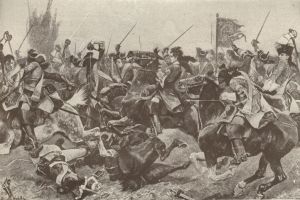France’s success at Fontenoy was added to by Frederick II almost concurrently in June 1745. Austria, still bitter about losing Silesia to the Prussians, sent Prince Charles of Lorraine with 60,000 Austrian and Saxon troops into Silesia. Frederick was not fazed by this offensive, because he believed Charles to be “stupid.”
Frederick believed Charles would cross the Riesengebirge (Giant Mountains of the Austrian Alps). He sent hussar detachments on a reconnaissance mission, which tracked Charles’ every move, and soon, Charles proved Frederick correct. Charles crossed the mountains, and Frederick was more than ready for the Austrian army. Charles’ army moved toward Hohenfriedberg Village, Poland, and the Saxons encamped near Pilgrimshain. Charles believed his position to be geographically sound as the Striegau river protected his front, while the Prussian army was across the river to the south.
Frederick’s assertion that Charles was “stupid” also proved exact, as the entire Prussian army marched northward in front of the Austrian force and crossed the Striegau river over a bridge and into the town of Striegau. From this new position, Frederick attacked the Saxons separately from the Austrians. He hoped to destroy Saxon influence and then turn eastward against the impotent Austrians. Charles was not entirely stupid, Frederick did use trickery to move an entire 60,000 strong army in front of the Austrians. His first design was to march at night, while the Austrians were asleep. Frederick ordered his men to leave the campfires burning in order to confuse the Austrians. No talking or smoking was allowed during the night march so as to remain undetected. Frederick also encountered his fair share of mistakes. The bridge used to cross into Striegau was too small for the entire army to cross. Troops bottlenecked, and only a few crossed by 700 am when Frederick’s commander De Moulin ordered an attack. The surprise was realized when a Saxon contingent skirmished with the newly arrived Prussians.
The Saxon soldiers were largely unprepared for the swiftly onrushing Prussian cavalry. Few Saxons assembled to meet the onslaught, and were quickly routed. Prussian infantry soon followed as the remaining troops crossed the Striegau river wherever they could. The Saxons were still waking from sleep, and could muster no defensive hold. By the time the sun had risen past dawn twilight, half of the Austro-Saxon army was destroyed. The remaining half was finally alerted and ready to engage the Prussian offensive. The quicker Austrian cavalry arrived to the challenge first, but were outmaneuvered by the superior Prussian Dragoons. Two lines of Austrian infantry arrived and opened fire into the Prussian ranks at close range. Regardless, the Austrians were now vastly outnumbered, and the wind literally changed to aid Frederick’s men. 18th Century firepower produced a lot of smoke, which blinded soldiers. The wind cleared this smoke and revealed a hole in the Austrian ranks, while also providing cover for the Prussian Bayreuth Dragoons. The Dragoons spotted the gap, and ran through the hole well behind the Austrian front line. The 1,500 advance cavalry men ran down the length of Austria’s infantry cutting it to pieces. Once the first line was smashed, the Dragoons turned and smashed the entire second line. Austria was humiliated. The remaining soldiers surrendered in large numbers, as the 1,500 Dragoons inflicted several thousand casualties against the Austrians, while only suffering 94 itself.
Frederick gloriously won the day, and was from this point on called “The Great.” His victory was celebrated throughout Prussia and France for decades, and is still studied by generals today. His cavalry charge was also immortalized in song, the Hohenfriedberger Marsch, which many believed to have been written by the musician, general, king Frederick II himself. The Prussian victory signaled the real end of the Second Silesian War, and Maria Theresa was forced to sign the Treaty of Dresden after subsequent defeats throughout 1745. The Quadruple Alliance gains up to 1744 were lost, as France and Prussia ran untamed throughout Europe.























